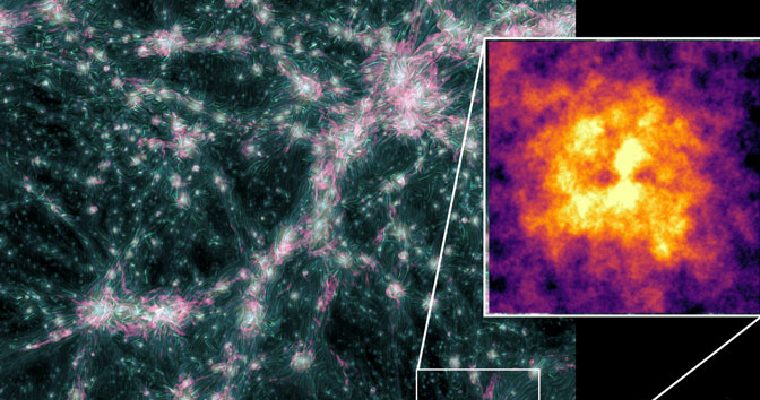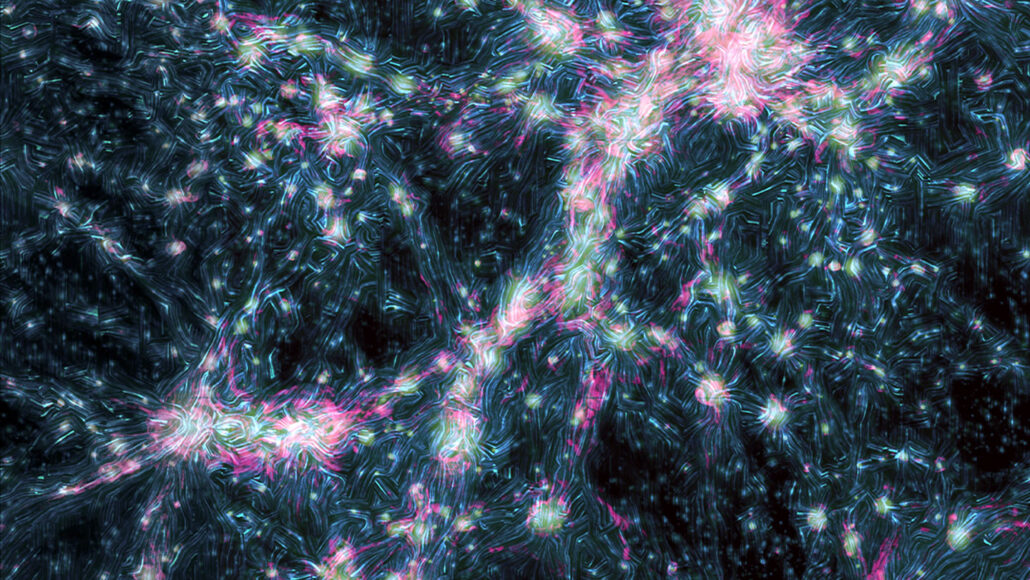Astronomers have detected shock waves rippling along the strands of the cosmic web for the first time, which could provide an indirect look at large-scale magnetic fields in the universe. By combining hundreds of thousands of radio telescope images, researchers were able to reveal the faint glow cast by shock waves as they send charged particles flying through the magnetic fields that run along the cosmic web. This discovery could provide valuable insights into the properties and origins of these mysterious large-scale magnetic fields. The research was reported in the February 17th edition of Science Advances.

The recent discovery of shock waves rippling along the cosmic web of the universe confirms what has been only predicted by simulations until now. This significant finding provides valuable insights into the structure and evolution of the universe. Astrophysicist Marcus Brüggen of the University of Hamburg in Germany, who was not involved in the study, stated that this discovery confirms the existence of shock waves in the cosmic web that was only theoretical until now.
At the grandest scale, the universe resembles Swiss cheese, with galaxies clumped together in enormous clusters connected by ropy filaments of dilute gas, galaxies, and dark matter, separated by not-quite-empty voids. Tugged by gravity, galaxy clusters merge, filaments collide, and gas from the voids falls onto filaments and clusters. In simulations of the cosmic web, all of this action consistently sets off enormous shock waves in and along filaments. These shock waves are created by the collision of massive objects such as galaxy clusters, releasing energy that travels through the cosmic web, resulting in a ripple effect. This discovery opens up new avenues for research and understanding of the mysteries of the universe, including the properties and origins of the large-scale magnetic fields that run along the cosmic web.

Filaments are the primary components of the cosmic web, but they are much harder to detect than galaxies. While shock waves around galaxy clusters have been observed before, shocks in filaments have never been seen until now. Astronomer Reinout van Weeren of Leiden University in the Netherlands, who was not involved in the study, notes that shock waves around filaments should be present throughout the cosmic web. These shock waves would accelerate charged particles through the magnetic fields that permeate the cosmic web, resulting in the emission of light at wavelengths that radio telescopes can detect. However, the signals are very weak and challenging to detect.

The image depicts a simulation of the cosmic web and its magnetic field in cyan, with shock waves along filaments and around galaxy clusters emitting weak radio signals in pink. The simulation suggests that these shock waves should accelerate charged particles through the magnetic fields present in the cosmic web. As a result, the particles emit light at wavelengths that radio telescopes can detect, although the signals are very weak. The inset in the image shows what combining many radio images of galaxy cluster pairs in the simulated cosmic web might look like, with colors representing gas temperature and density. High values are shown in yellow, while low values are shown in purple and black. This simulation provides valuable insights into the structure and evolution of the cosmic web and the properties of the magnetic fields that run along it.

Simulations of the cosmic web and its magnetic field predict that shock waves along filaments and around galaxy clusters should emit weak radio signals. However, detecting these signals is challenging since a single shock wave in a filament would look like noise. Therefore, radio astronomer Tessa Vernstrom of the International Centre for Radio Astronomy Research in Crawley, Australia, and her colleagues combined radio images of over 600,000 pairs of galaxy clusters connected by filaments to create a single “stacked” image. This amplified weak signals and revealed that, on average, there is a faint radio glow from the filaments between clusters.
The faint signal is highly polarized, meaning that the radio waves are mostly aligned with one another. This highly polarized light is unusual in the cosmos, but it is expected from radio light cast by shock waves. This discovery provides strong evidence that the shocks are indeed present in the cosmic web. Moreover, it offers a rare glimpse of the magnetic fields that permeate the cosmic web, albeit indirectly.
The shocks detected in the cosmic web confirm the predictions of cosmic web simulations and reveal the existence of large-scale magnetic fields that surround the filaments. However, the origin and role of these cosmic magnetic fields in shaping the cosmic web remain mysterious. Nonetheless, this discovery provides valuable insights into the structure and evolution of the universe and the nature of its fundamental forces, including magnetism.








